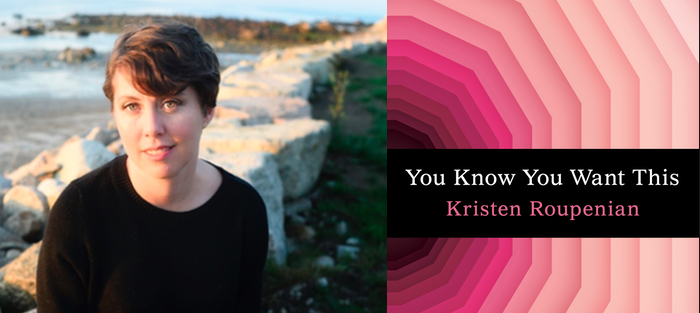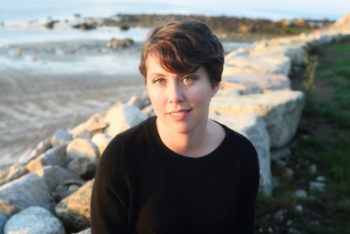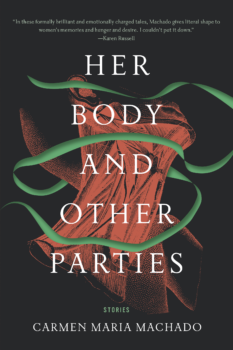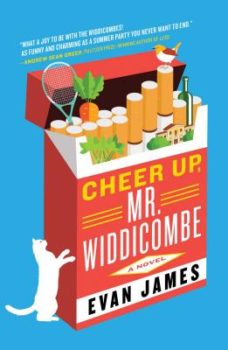Before Kristen Roupenian began writing fiction in earnest, she had resigned herself to living what she describes as her “second best life.” Kristen grew up in Plymouth, Massachusetts, attended Barnard where she double-majored in English and Psychology, and then volunteered with the Peace Corps in Kenya. After, she worked as a nanny for a couple years before attending Harvard for a PhD in African Literature. And though she had always been passionate about writing, she describes the process back then as agony, full of false starts and frustration. “I could just barely claw my way through a story,” she said of those years. So she applied to a job with the State Department, ready to settle into a life where she believed she knew everything that would happen.
But during a dark-night-of-the-soul conversation with her father, expressing her frustration about how fixed her future felt, Kristin came to understand that she didn’t really know everything that could happen, that so many interesting things could still happen if she pursued the life she was most passionate about. And in accepting the possibility of failure, the writing became less agonizing. She got a second life, one where unlikely but wonderful things could happen. In 2017, she received her MFA from the Helen Zell Writers’ Program at the University of Michigan. That same year her story “Cat Person” was not only published in The New Yorker, but it also achieved something short fiction rarely does: it went viral and became one of the most-read online pieces of the year, as well as the most-downloaded fiction pieces in The New Yorker’s history.
Though we met in the MFA program, I was introduced to Kristen’s work through “Cat Person.” I was struck first by the preciseness of the prose: this was a writer who said exactly what she meant, who wasn’t afraid to unsettle with her gift for verisimilitude. The eleven other stories in Kristen’s debut collection, You Know You Want This (Gallery/Scout Press), are as arresting, compelling, and thought-provoking as “Cat Person.” There are fairytale queens, spellbooks, and many-limbed monsters. There are awkward teenage girls and sadists and Nice Guys who inflict the pain they’ve had to endure. The start of every story is a thrilling displacement—we never know which world we are about to inhabit, whether the monsters in it will be real or will only seem real.
For this interview I met Kristen in her cozy writing loft on a dreary Michigan day. As we discussed the limits of genre, narrative empathy, and a writer’s responsibility, her charcoal-gray kitten Angus attacked our feet and dipped his paws into our water glasses, rendering my “so, are you a cat person?” entirely redundant.
Interview:
Michelle Cheever: It’s incredible enough to have a story published in The New Yorker, nevermind have that story go viral. What was your reaction to “Cat Person” being published, and how are you doing now?
Kristen Roupenian: The moment the story got into The New Yorker was one of the best experiences of my life. Just pure disbelief and joy. It’s easy to get lost in the weirdness of everything that happened after, but that was unprecedented. That is not a thing that happens!
After that, I was lucky because the book sold so fast that my editor and agent were like, “You don’t have to talk to people. You don’t have to engage. You don’t have to have these conversations about your work or about yourself. You can just go dark.” And I did. That was really helpful. Then I looked at the conversation in manageable doses and stayed relatively grounded.
Why do you think “Cat Person” struck a chord with so many readers?
There is no way to know. In a lot of ways, virality is just a thing that happens. There’s not a reason for it in some ways. Things have a certain momentum and then other things happen and algorithms kick in and suddenly something is happening that’s separate from whatever the internal quality of the thing is.
I think there could have been a thousand stories that had the same qualities that wouldn’t have gone viral, or wouldn’t have had this happen to them. But the thing about “Cat Person” that maybe allowed for that was that the timing was right and it caught the wave of a bigger conversation.
Also, when I was in workshop and people would criticize my stories, a thing they often said about my writing—that I think is true—is that it is kind of light on character. There is a…not skeletal, but somewhat sketchy way that I write characters that lets you fill in a lot of the blanks yourself. And I think that one of the things that happened with “Cat Person” was that a lot of different kinds of people saw experiences that they’d had in the story .
What did you make of so many people reading the story as an essay? I wonder if it has something to do with people not having looked at fiction for a long time and then being surprised at how a story can capture such ineffable things in such a particular, concrete and true way. In my own writing I sometimes get stuck in an 18th century mode of making things flowery, timeless, and unspecific. There’s a lot of ways that you did not seem determined to have the story be “timeless”—whatever that means. You were able to touch on things like the banter that we find in texting, leggings on a date, and reading into emojis in a way that felt very real.
It’s so interesting how consistent it is that young women, especially, find a thing they love, passionately read it and discuss it, and then everyone gets mad about the way they have read and discussed it. I feel protective of readers who came to it and read it in all these different ways and then there were a bunch of think pieces being like, “Everyone read this story wrong.” I’m like, “Fuck you, whatever. No, they didn’t.”
The experience of young women and dating and sex feels like completely well-trodden territory, and so it seems absurd to claim no one writes about the internal experiences of young women. That’s true and not true at the same time. The hunger, the intensity with which people responded to “Cat Person,” meant that it did give them something they weren’t finding. The idea that there’s space in there that’s still new is hard to wrap your brain around, but I do think it’s true.
Do you feel like readers that are now familiar with your work will be surprised by the range of subject and style in your collection of stories, You Know You Want This?
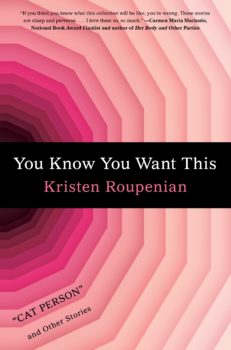 Yeah, I mean, it’s surprising! It’s definitely not ten other “Cat Person” stories. One of the things I really liked about Allison [my editor] was the way she got the collection as a whole and wanted it to be what it was. I never felt like any of the suggestions she made were about making all the stories more like “Cat Person.” That I was really grateful for.
Yeah, I mean, it’s surprising! It’s definitely not ten other “Cat Person” stories. One of the things I really liked about Allison [my editor] was the way she got the collection as a whole and wanted it to be what it was. I never felt like any of the suggestions she made were about making all the stories more like “Cat Person.” That I was really grateful for.
There’s a lot more genre. A lot more extreme subjects. There’s a lot more darkness and violence and monsters. I feel okay with people picking up the collection, looking through it, reading the first couple pages, and being like, “Oh, this is something different.” I want them to know what it is before they buy the book and then are shocked.
Is that why we start with “Bad Boy,” a story about a couple who slowly seduces their hapless single male friend into their sadistic sex life?
That’s part of it, for sure, though that was the first story in the collection even before “Cat Person” was published. It wasn’t a corrective to CP, exactly, but it was really important to me that the collection started with a bang. I wanted you to feel by the time you got to CP that anything could happen because of the mix of horror and more traditionally realistic stories in the book.
One of the things I also wanted to happen over the course of the collection was to unsettle people enough that even when they were reading realism, they didn’t know that they were reading realism because it was totally possible that someone could get killed or someone could turn into a monster. So I was imagining CP in the context of the larger story collection. This to me was the core aspect of those moments where Margot’s imagining, “What if Robert kills me?” I wanted people to think that could happen because of the story collection, not just because of the world. I’m excited for people to hopefully be able to see that story in a different light, through the lens of stories like “Bad Boy,” where some of the darker possibilities are realized.
There is definitely that sense throughout the collection that we’re in a realist world but seeing things through the lens of horror. Can you tell me about how you use the various elements of the horror genre?
That’s a good question but a hard one. One of the things that all the stories have in common, whether they’re genre—whatever that means—or not, is a sort of propulsive dread pulling you through them. But the techniques that create that feeling, they’re not different, necessarily. The sense of dreadful foreshadowing is not limited to one genre or the other. “Oh, shit, something really bad is going to happen, I just don’t know what…” That feeling doesn’t need to live only in genre or only in realism.
The title. When I was picking it one of the things I realized was that you could slot it into almost any of the stories. It wouldn’t have been out of place as a line of dialogue in any of them. When you have through lines like that, you can have a story like “Sardines,” which ends in a writhing mass of human monsters, and “Good Guy,” where truly nothing happens other than people arguing. But you see the connection, that same sort of “nnughfff” feeling. It’s kind of visceral and uncomfortable. The more stories you go through heightens that overall sense of discomfort.
Both with genre and realism it limits the feeling of anything could happen, which is a really good moment to get your reader to. If you’re in a horror story and you know you’re in a horror story, the reader thinks, “I know what’s going to happen—something horrible is going to happen. Someone is definitely going to get murdered here.” That takes away from tension. The floor-dropping-out-from-under-you feeling is most easily achieved when you don’t know which kind of world you’re in.
Girlhood and femaleness in this collection are regularly interrogated through this lens of the grotesque and monstrous. Mothers and daughters become a many-limbed, seething monster. A group of schoolgirls become devilish tormentors of their teacher. A young woman scratches at her skin, certain she’s infected with parasites. Are you saying something specific about girlhood, particularly adolescence, by using elements of horror?
Certainly, but I would suggest that there are also monstrous men in the collection, and I think that’s important to remember, too. It’s not just the women who are gross. Equal opportunity disgusting.
Although I do absolutely think adolescence—and I’ve only experienced adolescence as a female—but I do think that the particular horror of being a teenage girl, which is about bodies and about a feeling of monstrousness or horror, is like a slipping of control. For me, at least, becoming a teenager was feeling like I was dissolving into this collective. That only other people’s opinions mattered, that you didn’t know who you were compared to other people, and then entering the kind of horrors of—or at least coming up against—“the patriarchy,” or whatever. Seeing exactly what it was going to be like to be a woman in the world was horrifying! And all of that’s happening at once. So I definitely think that’s a natural space for horror. Horror movies have been playing on that trope from the beginning of time. But it’s only one of many varieties of monstrosity in which I am interested.
In several of these stories you write about a very particular kind of misogyny I have not seen explored much in fiction before. The point of view characters in “The Good Guy” and “Death Wish” are vulnerable, but in that intimate access we get to their emotional world, the main thing we witness is their self-loathing. Their self-loathing does something interesting in that it translates into a hatred of any woman who shows interest in them.
Do you think that misogyny is actually self-loathing turned outward? Is it an act of empathy to write from these points of view?
I like the assessment of those things a lot. I haven’t thought about them in exactly those ways, but that seems right to me.
Surely there are as many kinds of misogyny as there are people in the world. So I’m sure that’s only one sliver. I doubt it’s the secret key that unlocks all misogyny. You don’t see the world apart from the way you see yourself. Those things are interlocked.
It’s funny for me, right? I am a lady. My understanding of what misogynistic men are thinking is just speculation, so I think it’s interesting to think about. Many stories for me start with imagining a situation or imagining a kind of person and then trying to wrap my brain around it or them. When I’m writing a man I’m not just writing “a man”; I’m writing other things that are in my head. I’ll see myself doing something that isn’t great, and I’ll be like, “Why am doing that?” I’ll look at it and amplify it—and amplify it and amplify it—and then that’s the story. Sometimes people are like, “That person’s horrible!” And I’ll be like, “Truly! They’re garbage!” Of course, I haven’t lived out the whole arc, but I’m trying to play something out to its logical extreme.
One thing I do think is that empathy—which is often coded as female, or is something that women tend to own and then want of men—is a very double-sided sword. All empathy is is imagining what other people are thinking. There’s no reason that has to be positive or good. When you’re imagining what someone is thinking and then you’re thinking what they’re thinking about you, to me that’s a channel that has so much space for darkness. In both “Good Guy” and “Death Wish,” one of the things the stories do is push this idea. At the end of “Good Guy,” he’s like, “I’m imagining that she’s imagining that I’m stabbing her.” That’s where you get.
It says more about you than it does about them, whatever thoughts you put in their heads when you’re trying to talk about this whole thing.
In the story “A Matchbook Sign,” a man watches helplessly as his girlfriend is consumed by the belief that parasites are living under her skin. While reading it I had this impulse to figure out what it was “really” about, to see if the horror of the story’s situation was really a metaphor for the all-consuming nature of relationships, or if it was really a story about how to love someone whose suffering you do not understand, or if it was about how men think women are delusional, and on and on in a way that isn’t exactly looking for theme, but rather for a direct translation from horror to meaning.
Do you think we are more inclined to read horror as metaphor?
That seems true when you say it like that; that it can’t just be itself, it has to be standing in for something else. But it’s maybe akin to writing “The Good Guy” and saying, “What is this about? Capital ‘A’ Nice Guys?” There’s an impulse that’s natural but also maybe amplified to say what a story’s about in one way or another, whether it’s a social message or “How can I unpack this metaphor?”
When I am the most engaged in a piece of writing, I am just compelled by it. It’s that “first read” feeling that I’m always going for, where you’re like, “What’s gonna happen, what’s gonna happen, is the bug gonna eat her?” That is the thing I’m trying to do. It leads to bad stories when I’m trying to give people answers—What is the metaphor? What is the meaning?—whether on purpose or in retrospect.
“Matchbook Sign” is one of the stories that has been most workshopped. And a thing that I discovered from workshop is feeling like you need to be able to explain your story completely because people are going to ask you to. And I actually don’t think that you do.
It’s fun now to talk about CP and be like, “What does that story mean?” Because the truth is when I was writing it I wasn’t thinking about what it meant at all. And then surprising things can happen. People can tell you things about your story you didn’t see. When you spend too much timing believing “I’m writing a story about a parasite but it’s really a metaphor for the all-consuming nature of relationships!” it’s like you, the writer, doing the work of the reader. It’s the reader’s job to get that and unpack it, but also just to experience it.
And your job is just to write something that someone will really love.
Or hate but want to keep reading. That’s what I want to read, you know? I don’t want to be thinking the first time I read, I want to just be like, woosh! Once you make people feel that way, they’ll want to talk about your stories. But if you start with, “I’m sure you might have a lot of questions about what this story means!” then they probably won’t.
It almost seems like magic or an act of the unconscious that all of these interesting themes and questions have made their way into the story. But, of course, those elements are there by virtue of the story being a good story.
Or you’ve been thinking about things for a long time. I’m a person in the world, there are ideas in the stories, but they’re coming out sideways and in surprising ways as opposed to carefully related.
Anything that’s bothering you now we’ll see in future work?
In a lot of ways, I think my themes are my themes. Power will always be in my stories. Intense interpersonal relationships, always. But the romantic focus of “Cat Person” might not necessarily be the core forever.
Families for sure. Because I’ve been so locked in on the one-on-one or two-on-one focus, I think writing about bigger spaces is a possibility. But I also think I have a relationship novel in me. Whatever the novel is—and I’m not sure what it will be yet—I imagine it will be on similar themes to the short stories, because I want to be in that space for a little bit longer.
Is that what you’re working on now, a novel?
I’m always working on a novel.

